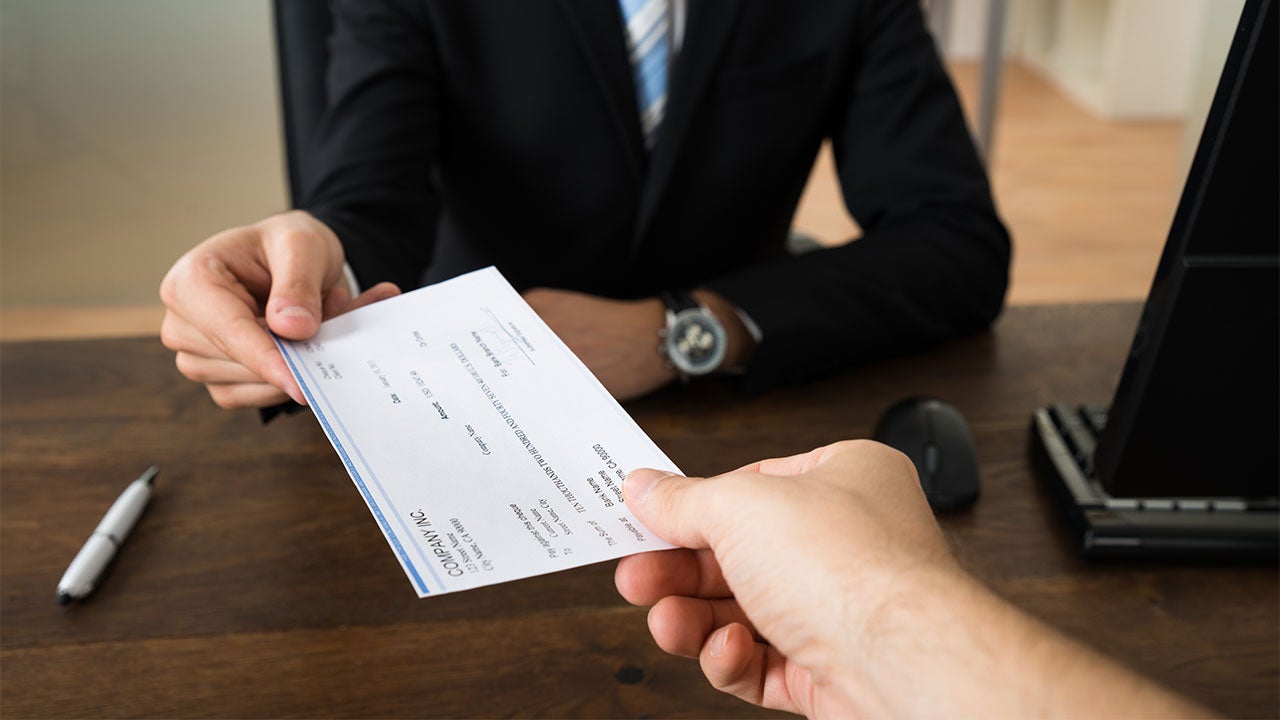What’s the difference between a cashier’s check and a money order?

Key takeaways
- Cashier’s checks are available through banks and credit unions, while money orders can be purchased from a wide range of places, including retail stores, postal service locations, banks and credit unions.
- Money orders are typically capped at $1,000, while most banks and credit unions will issue cashier’s checks for any amount.
- Fees for money orders tend to be relatively low – $5 or less. Some banks charge their customers $10 or more for a cashier’s check, and others don’t charge anything at all.
When you have to make a payment but you can’t use a personal check, credit card, cash or a simple digital option like Zelle, a cashier’s check or money order can be a good alternative.
Cashier’s checks and money orders are safer than personal checks and they won’t bounce. The two forms of payment, however, do differ. Read on to learn about what separates a money order vs. cashier’s check, how to get them and when it makes sense to use them for your payment needs.
What is a cashier’s check?
A cashier’s check is a paper check issued by a bank to a third party, usually on behalf of a bank customer, who pays the bank the face value of the check. Because the bank withdraws funds from the customer’s bank account beforehand, the check is guaranteed not to bounce.
Cashier’s checks can be purchased through banks and credit unions. If ordered online, the bank may limit the amount of money for the check. For larger amounts, you may need to visit a branch in person.
Cashier’s checks are typically used in larger transactions, such as at the closing of a home sale or purchase of a car or boat. Once a cashier’s check is issued, you can’t cancel it or put a stop payment on it — because the funds were already withdrawn.
Fees for cashier’s checks vary. Customers of big, traditional banks can expect to pay at least $10. Wells Fargo, for example, charges $10 and Bank of America charges $15 unless you’re enrolled in the bank’s Preferred Rewards program, which will get the fee waived.
Some banks don’t charge anything to customers for cashier’s checks, though. Ally, for example, doesn’t impose a fee for the service. Quontic, another online-only bank, doesn’t charge a fee for cashier’s checks or money orders.
Credit unions typically charge less than big banks, and in some cases, they don’t charge at all. Alliant Credit Union, for example, doesn’t charge a fee for cashier’s checks.
What is a money order?
A money order is a paper payment instrument that allows you to send money to a third party securely and inexpensively. The issuer is paid the face value of the money order in cash or by debit card or traveler’s check, so the payee can be confident that the money order is good for the amount specified.
Money orders are more secure than personal checks because they’re paid upfront. They’re widely available: Banks issue them, as do many grocery stores, convenience stores, gas stations, the U.S. Postal Service and check-cashing outlets.
Many issuers of money orders have a $1,000 maximum purchase limit. Money orders typically are used for smaller, everyday transactions, such as paying a utility bill or a deposit on a rental apartment. If you need to make a payment of more than $1,000, you could simply buy multiple money orders to cover the cost.
Money orders are cheaper than cashier’s checks. The U.S. Postal Service charges just $2.35 for a money order up to $500 and $3.40 for money orders from $500.01 to $1,000. Walmart charges a maximum fee of $1. Chase, the largest bank in the U.S., charges $5 for money orders.
When to use each payment method
Generally, cashier’s checks or money orders are appropriate when the payee wants to be sure that the payer has the funds. To obtain a cashier’s check or a money order, the full amount must be paid to the issuer upfront, so there’s no risk of the payment bouncing.
A cashier’s check or money order is guaranteed and can be redeemed only by the payee. With a cashier’s check, the issuing bank fills out the “pay to” line, which helps prevent the check from being fraudulently cashed if it’s lost or stolen.
Cashier’s checks and money orders have similarities, but each may be better suited to different circumstances.
When to use a money order
- You’re making a payment of less than $1,000
- You need to make a payment but don’t have a bank account
- The payee needs immediate access to the money
- You want an inexpensive way to pay bills or conduct everyday transactions
- You want a payment instrument that is highly accessible and easy to buy
- You need a payment instrument that is guaranteed not to bounce
When to use a cashier’s check
- You need to make a payment of over $1,000 for a major transaction, such as buying a home or car
- You want maximum security to guard against loss or theft of the money
- The payee needs quick access to the money
- You prefer a payment method you can get from your bank, either online or at a branch
- You don’t mind paying a substantial fee, usually around $10 to $15, for the service
- You need a payment instrument that is guaranteed not to bounce
Where to buy cashier’s checks and money orders
Cashier’s checks can be purchased through banks and credit unions. If you have a bank account, your bank might not charge you a fee for a cashier’s check, or you may be charged less than a non-customer.
Not all banks issue cashier’s checks to people who don’t have accounts with them, but many banks do, typically for an extra fee.
Money orders can be bought at a variety of places. Banks and credit unions issue them, as do many grocery stores, convenience stores, check-cashing outlets and the U.S. Postal Service.
Retailers also sell money orders, some with more reasonable fees. Prices, purchase limits and availability may vary depending on the store location. Be sure to have a photo ID with you before buying a money order.
Here are the fees charged for money orders at a variety of locations:
- U.S. Postal Service: $2.35 for amounts up to $500; $3.40 for amounts over $500 up to $1,000
- Walmart: Maximum fee of $1
- Chase: $5
- Kroger: Fees start at $1 with a Shopper’s Card and $1.10 without, varies by location
Differences between a cashier’s check and a money order
| Cashier’s check | Money order | |
|---|---|---|
| Cost per item | Typically $10 to $15 | Typically less than $5 |
| Availability | Offered by banks and credit unions, and in some cases, only to their own customers | Offered by financial institutions, supermarkets, post offices and other stores |
| Safety | No risk of bouncing, plus bank fills out “pay to” field | No risk of bouncing, though the payer is responsible for filling out “pay to” field |
| Restrictions | Usually no limit on amount, although a high check value may require an in-person visit | Usually limited to $1,000 or less |
| Best for | Large transactions with extra protection from the financial institution | Smaller transactions or when getting a check from a bank isn’t an option |
Are cashier’s checks safer than a money order?
A cashier’s check is safer than a money order because the “pay to” field is filled out by the issuing bank at the point of purchase. Only the payee, after providing personal identification, can cash or deposit the check.
With a money order, however, the name of the payee is filled out by the purchaser, and if it isn’t done immediately and the money order is lost or stolen, the money order can be cashed by anyone.
Scammers do try to duplicate cashier’s checks, so it’s a good idea to verify the check’s validity with the issuing bank before cashing or depositing it into your account.
Cashier’s checks are harder to replace than money orders if lost or stolen. The bank that issued the check might require you to buy an indemnity bond from an insurance company for the amount of the check. The indemnity bond makes you, not the bank, responsible for any losses if the check is cashed.
The bank also might make you wait 30 to 90 days before it will issue a replacement check.
Replacing a lost or stolen money order is easier. If you have the original purchase receipt, the outlet where you purchased it might replace it or give you a refund. You likely will have to pay a fee for the service.
Bottom line
Cashier’s checks and money orders offer a more secure way to make a payment than cash or personal check. For those without a checking account, they offer solid alternatives for making payments.
A cashier’s check is better suited to larger transactions, though it may come with a higher fee. Money orders may have limits on the dollar amount, but they come with low fees and are widely available.
–Freelance writer David McMillin updated this article. Former Bankrate writer René Bennett contributed to a previous update.
Why we ask for feedback Your feedback helps us improve our content and services. It takes less than a minute to complete.
Your responses are anonymous and will only be used for improving our website.






